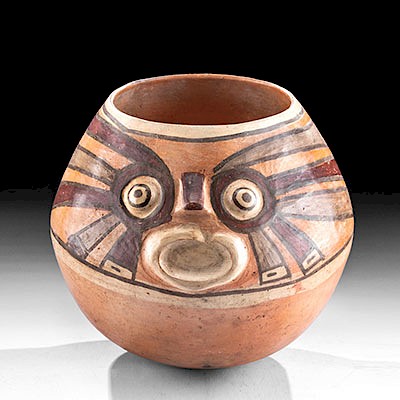Pre-Columbian Sican / Chimu Textile w/ Spider Oracles
Lot 102
About Seller
Artemis Gallery
686 S Taylor Ave, Ste 106
Louisville, CO 80027
United States
Selling antiquities, ancient and ethnographic art online since 1993, Artemis Gallery specializes in Classical Antiquities (Egyptian, Greek, Roman, Near Eastern), Asian, Pre-Columbian, African / Tribal / Oceanographic art. Our extensive inventory includes pottery, stone, metal, wood, glass and textil...Read more
Estimate:
$2,000 - $3,000
Absentee vs Live bid
Two ways to bid:
- Leave a max absentee bid and the platform will bid on your behalf up to your maximum bid during the live auction.
- Bid live during the auction and your bids will be submitted real-time to the auctioneer.
Bid Increments
| Price | Bid Increment |
|---|---|
| $0 | $25 |
| $300 | $50 |
| $1,000 | $100 |
| $2,000 | $250 |
| $5,000 | $500 |
| $10,000 | $1,000 |
| $20,000 | $2,500 |
| $50,000 | $5,000 |
| $100,000 | $10,000 |
| $200,000 | $20,000 |
About Auction
By Artemis Gallery
Dec 5, 2019
Set Reminder
2019-12-05 10:00:00
2019-12-05 10:00:00
America/New_York
Bidsquare
Bidsquare : Ancient / Ethnographic - Holiday Edition
https://www.bidsquare.com/auctions/artemis-gallery/ancient-ethnographic---holiday-edition-4710
What to give this holiday season? Ancient & Ethnographic Art of course! Our special Holiday auction features hundreds of unique finds from all over the world. Artemis Gallery info@artemisgallery.com
What to give this holiday season? Ancient & Ethnographic Art of course! Our special Holiday auction features hundreds of unique finds from all over the world. Artemis Gallery info@artemisgallery.com
- Lot Description
Pre-Columbian, North Coast Peru, late Sican/Lambayeque to early Chimu, ca. 900 to 1100 CE. A beautiful textile of draped ovoid panels comprised of tightly woven camelid (alpaca or llama wool) fibers in hues of crimson, cream, wheat, periwinkle, and maroon. Within each of the twenty-three panels is an abstract oracle spider with a hairy abdomen, slender legs, and a petite circular head surrounded by several additional pincered arms. The tops of the panels are connected via a narrow rectangular strip with tufts of red and beige fabric. Mounted atop a museum-quality display fabric. Size (textile): 69" L x 5.75" W (175.3 cm x 14.6 cm); (display fabric): 83" L x 22.25" W (210.8 cm x 56.5 cm).
Many forms of divination existed among the ancients of Peru, with prognostication instruments ranging from small stones to leaves, bones, and intestines, and small animals like snakes and spiders. During rituals of spider divination, according to independent researcher and art curator Vanessa Drake Moraga, "diviners either kept or trapped large 'hairy' spiders to consult for omens. The spiders were case onto a special ceremonial cloth, and their legs were examined for unusual breaks and positions." (Moraga, Vanessa Drake. "Animal Myth and Magic: Images from Pre-Columbian Textiles." OLOLO Press, Larkspur, California, 2005, p. 158).
Provenance: ex-private Hans Juergen Westermann collection, Germany, collected in 1950 to the 1960s
All items legal to buy/sell under U.S. Statute covering cultural patrimony Code 2600, CHAPTER 14, and are guaranteed to be as described or your money back.
A Certificate of Authenticity will accompany all winning bids.
We ship worldwide and handle all shipping in-house for your convenience.
#150524Minor fraying and loosening to some fibers, with light staining and fading to original pigmentation. Arachnid iconography is still visible and clear.Condition
- Shipping Info
-
All shipping is handled in-house for your convenience. Your invoice from Artemis Gallery will include shipping calculation instructions. If in doubt, please inquire BEFORE bidding for estimated shipping costs for individual items.
-
- Buyer's Premium



 EUR
EUR CAD
CAD AUD
AUD GBP
GBP MXN
MXN HKD
HKD CNY
CNY MYR
MYR SEK
SEK SGD
SGD CHF
CHF THB
THB













